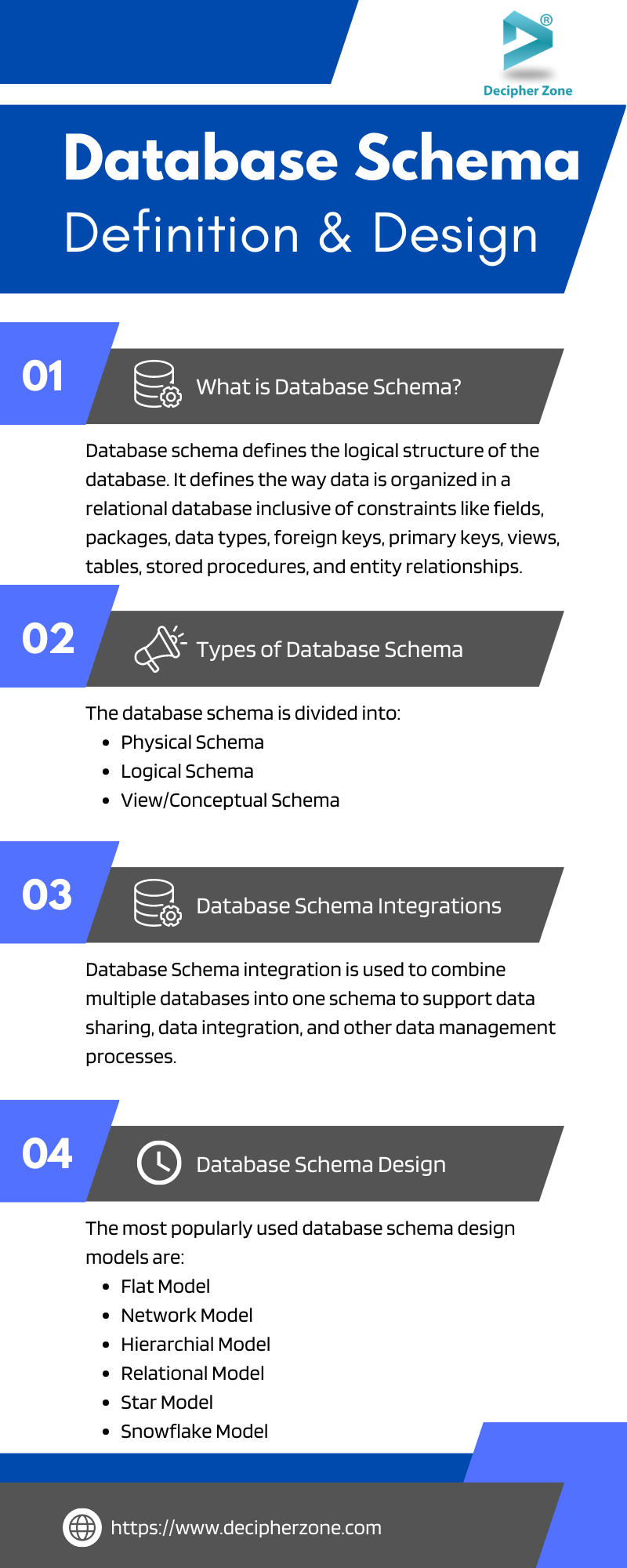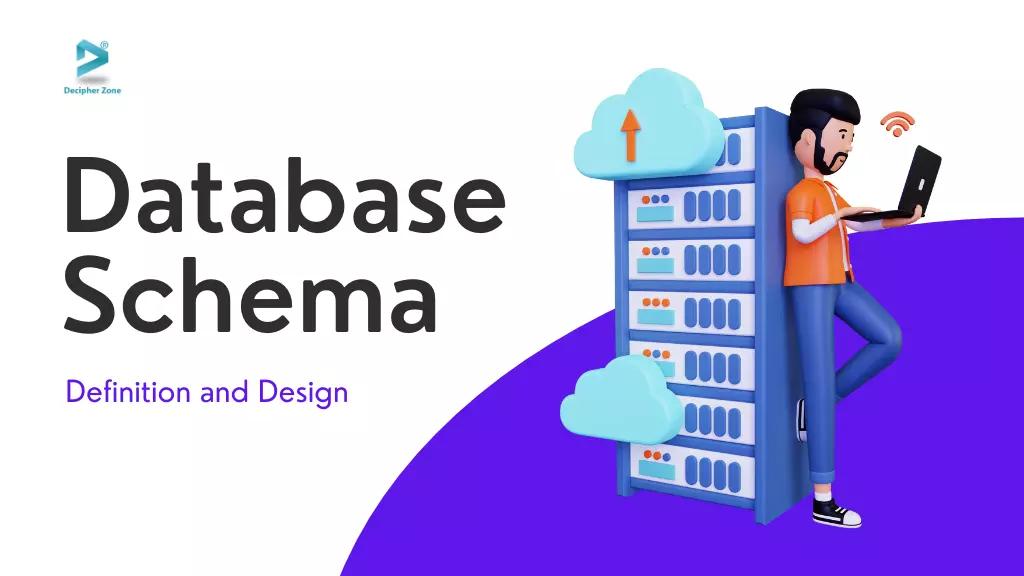What is Database Schema and It's Types, Benefits & Design. With businesses generating an enormous amount of data than ever before, effectively managing data becomes crucial. Moreover, according to PR Newswire Research, the global database market size is expected to grow at a CAGR of 21.9% and reach around $5996.24 million by 2028.
That being said, to create, access, and maintain databases efficiently, database schema plays a major role.
But do you know what database schema is, or the benefits it holds? In this article, we will discover everything you must know about databases, especially if you are a data-driven business.
What is Database Schema?
Database schema defines the logical structure of the database. It defines the way data is organized in a relational database inclusive of constraints like fields, packages, data types, foreign keys, primary keys, views, tables, stored procedures, and entity relationships.
Read: Database For Web App Development
A database schema can exist both as a set of formulas in a DDL (data definition language) and as a visual representation to communicate the database architecture. Also, it represents table relationships and data organization simultaneously. Designing data scheming is what we call data modeling.
Read: Graph DataBases
In simple terms, a schema refers to the blueprint, framework, or structure used by programmers to create a database. It helps a database user understand the stored information.
A database schema consists of all data entries formatting, unique keys, name, and data type of each column.
Types of Database Schema
With a clear understanding of what a database schema is, it is time to take a look at its types. The database schema is divided into the following types:
-
Physical Schema provides technical information about how the data will be stored on a storage system physically in the form of Indices and Files. It also includes syntax used to create data structures within the storage.
-
Logical Schema specifies all the logical constraints such as tables, views, and integrity constraints to be applied to the stored data. Simply put, it consists of any rule needed to govern the database.
-
View/Conceptual Schema shares a broad view of what a database system consists of. It generally specifies the interactions of users with the system.
Benefits of Database Schema
But, what makes the database schema crucial to the modern database's structure? To help you understand, we have enlisted the benefits of the database schema.
Read: How to Build Data Warehouse
-
As database schema offers a clear logical outline about how the data is stored, it makes validating data more secure for administrators while ensuring that the database is performant and functional.
-
As the data stored in the schema is broken into multiple entities, accessing information and manipulating security levels for sensitive data becomes easier.
-
A thorough and clear database schema makes it easier for engineers, administrators, and other data analysts to understand and communicate aggregation methods and design constraints.
-
Also, a well-designed database schema removes the need for preprocessing and reverse-processing, allowing analysts to easily understand the analytics through an effortless report and dashboard creation.

Integration Requirements for Database Schema
Database Schema integration is used to combine multiple databases into one schema to support data sharing, data integration, and other data management processes.
For successful schema integration, one must identify and analyze the source schema, specify the target schema, map the source to the target schema, merge them, remove bugs and conflicts, and finally test the schema integration.
However, to ensure smooth integration of database schema, the following requirements matter the most.
Normalization
-
It refers to the process of database organization to minimize redundancy from a set of relations. Also, the relationships and independent entities from the source code should be grouped individually rather than in the same relation to improving data integrity.
Minimality
-
It means that no schemas should be lost or dropped, as losing elements of schema can make the integrated schema inadequate.
Overlap Preservation
-
The overlapping elements should be in the database schema table.
Extended Overlap Preservation
-
The schema elements, whether they are source-specific or source-overlapped, should be passed through the database schema.
Database Schema Design
Choosing the right database schema design for your project.
- Flat Model
- Network Model
- Hierarchical Model
- Relational Model
- Star Schema
- Snowflake Schema
A database schema design ensures data all entries have primary keys, consistent formatting, and all the important data integrated.
To help database engineers, there are certain models designed to govern database creation. The most popularly used database schema design models are:
Flat Model
It is the simplest two-dimensional model that consists of the same type of data and elements. It is similar to a single spreadsheet with no relations. The flat model is most suitable for applications that do not require complex data storage and analysis.
Network Model
It represents a series of nodes and vertices with many-to-many relationships. The network model signifies a flexible representation of objects and relationships. This model is great for representing workflows where multiple paths drive to the same result.
Hierarchical Model
This has a tree-like structure with root and child nodes of data and works in one-to-many relationships. It is most suitable for storing nested data.
Relational Model
It defines the relationship between data stored in a database’s tables, rows, and columns. A relational model is used to manipulate data and analyze different values.
Star Schema
It is a multidimensional data model used to store and analyze huge amounts of data. Star Schema can be integrated with data warehouses, data marts, databases, etc. It is best suited for querying large sets of data.
Snowflake Schema
It is a star schema extension where dimensions are divided into sub-dimensions. Snowflake schema represents the logical table arrangement in a multidimensional database, depicting a snowflake shape. Put simply, here the multiple dimensions are attached to a single centralized table.
How Can Decipher Zone Help?
Database Schema is the backbone of successful database creation and is necessary for almost every business that wants to store, maintain, retrieve, and analyze data.
We at Decipher Zone have a team of experienced database developers that you can hire for creating a web app with a strong database. All you got to do is send your requirements to our experts to acquire a customized quote for your project development.
FAQs
What are the 3 types of database schema?
Physical, logical, and view/conceptual schema are the three types of database schema you can work with.
What is a database schema?
A database schema refers to the blueprint, framework, or structure used by programmers to create a database.
What are the integration requirements of database schema?
Normalization, Minimality, Overlap, and Extended Overlap Preservations are the most basic requirements when it comes to schema integration.

